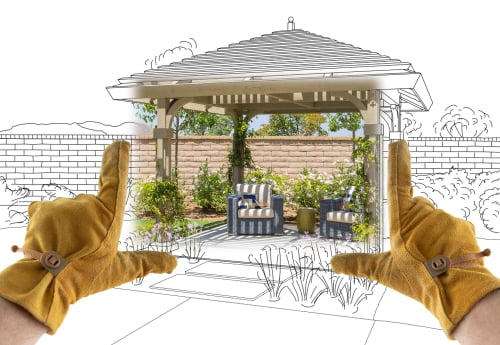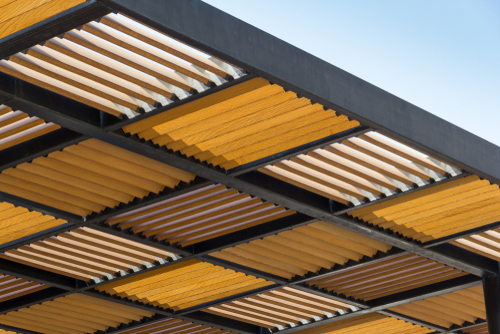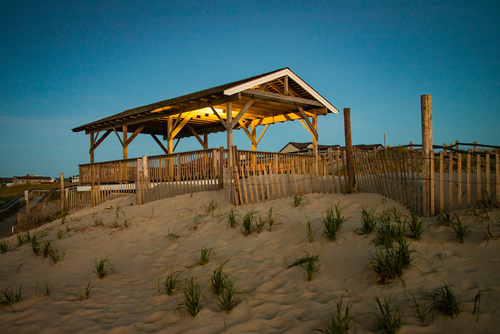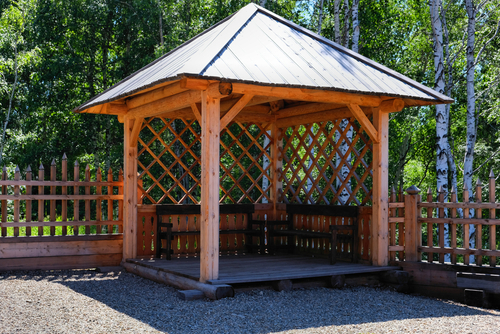Summertime is a great season for outdoor living! While it is relaxing and fun to spend summertime in a backyard or garden, not everyone enjoys exposing themselves to the rays of the sun for days on end. Sometimes, the shady areas are the most desirable. In the shade, you can enjoy the fresh air, gentle breeze, and warm temperatures without the intensity from the direct sunlight.
There are many different types of permanent outdoor shade structures. Let’s take a look at some of the appealing and functional permanent outdoor shade structures that can provide shade for backyard, garden, and patio spaces.
Pergola
A pergola is an outdoor shade structure that is supported by four beams, has a patterned roof that is partially open, and is open on all sides. Pergolas can be freestanding or connect to a home or other outdoor structure. Pergolas are intended to allow for air circulation and sunlight to pass through. Vines like wisteria and honeysuckle are commonly grown on pergolas, and sheer curtains or screens can be hung to add a little privacy.

A pergola can be made with pressure treated wood, cedar, or vinyl.
Pergolas are beneficial because they allow air circulation, provide the least amount of obstruction to the view, create a nice outdoor living space, and require very few materials to build. The drawbacks of pergolas include their susceptibility to termites and weather deterioration and the lack of complete protection from the elements.
Patio Cover
A patio cover is constructed overhang that keeps the area underneath in the shade and protected from the rain. Because of the sturdy, functional design, many people put fans, misters, entertainment equipment, and other features underneath the patio to create an enjoyable outdoor space. There are many ways to utilize the space created by a patio cover. A patio cover can create an environment for outdoor dining, relaxing by the pool, or enjoying entertainment.

If you want to block nearly 100% of harmful UV radiation and still allow light to pass through the patio cover, use TUFTEX PolyCarb corrugated panels. To learn more about this innovative, affordable, and durable material, read this article. For an opaque, shady affect, use ONDURA® roofing panels.
The pros of a patio cover include enjoyable shade, protection from the elements, and stylish aesthetic. For those who want to experience a closer integration with nature, patio covers may present a downside of too much protection from weather.
Pavilion
A pavilion is a fully-covered structure with a pitched roof and fully open sides. This kind of permanent outdoor shade structure is typically bigger than many other types of outdoor shade structures and offers many opportunities for creative design. Pavilions are usually supported by four to six posts and can either be freestanding or attached to your home.

A pavilion can be made with pressure treated wood or cedar posts and beams topped with a stately ONDURA® Edge uniquely corrugated roofing panel. This material resembles metal profiles without the sharp edges or risk of corrosion. Additionally, Ondura Edge will not resonate noise or radiate heat.
The pros of a pavilion include that this option provides a large amount of shade, has a solid roof for shelter against the elements, can be upgraded in a variety of ways, and can add value to a home.
The cons of a pavilion may include the large footprint, additional materials, and more involved construction processes.
Gazebo
A gazebo is a hexagonal or octagonal outdoor structure with a sturdy roof, semi-open side railings, and additional decorative elements. These embellished permanent outdoor shade structures are commonly placed in an area with a nice view. A gazebo can be freestanding or attached to a wall. Some gazebos include screens to prevent bugs from entering the space inside.

A gazebo can be made with cedar or pressure treated wood, lattice, decorative elements, and an ONDURA® Premium Series roof that will keep the structure cooler on sunny days and quieter during storms.
The pros of a gazebo include a generous amount of shade, the option to install screens to keep insects out of the space, the look of elegance and charm, and the option to upgrade with decorative elements or other functional features. The cons of a gazebo may include the large amount of yard space required for the structure and the additional costs to build and maintain the more elaborate design.
A gazebo is a hexagonal or octagonal outdoor structure with a sturdy roof, semi-open side railings, and additional decorative elements. These embellished permanent outdoor shade structures are commonly placed in an area with a nice view. A gazebo can be freestanding or attached to a wall. Some gazebos include screens to prevent bugs from entering the space inside.
How to Choose
With so many great options, it can be difficult to choose the best design for your backyard. To make your selection, consider the following:
- What space is available for the permanent outdoor shade structure?
- How much protection do you need from the sun and rain?
- Do you want a simple or decorative space?
- What is your desired aesthetic?
- How will you use the shaded space?
No matter what design you choose, Onduline has the roofing materials you need to build a sturdy, durable, appealing, functional, and permanent outdoor shade structure.
For more DIY inspiration and materials, visit the Onduline site today.